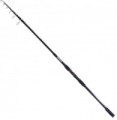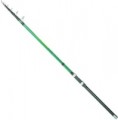Rod action
The action the rod matches. This parameter is often associated with spinning models (see “Type”), but it can also be indicated in other varieties.
Action characterizes the overall rigidity and elasticity of the rod blank - the main working part located between the handle and the upper end. In practice, the characteristics of bending and straightening during casting depend on this indicator. The
“faster” the action of the rod, the stiffer it is, the smaller part of it (counting from the upper end) bends when casting and the faster the structure returns to its original state. Conversely, a slow action means that the rod bends almost along its entire length and returns back at a relatively low speed.
If we talk about specific numbers, then models that bend 1/3 of the length or less are considered
fast, and models
that bend 2/3 of the length or more are classified as slow. Between these numbers there are intermediate indicators:
medium-fast,
medium and
medium-slow.
The progressive or complex system stands apart from others. The main feature of such rods is that when casting, they work as a fast-action rod, and when fishing for large prey, they exhibit the properties of a medium or even slow action, bending as t
...he load increases in the shape of a parabola and at the same time dampening the jerks of the fish. Progressive rods combine the advantages of fast and slow blanks in one bottle, but they are more expensive than their traditional counterparts.
The choice of fishing rod depends primarily on the expected fishing conditions. Thus, fast models are well suited for situations where there is no space for a swing - they allow you to throw the bait quite far due to just one movement of the wrist. Such products are considered more accurate; with a fast rod it is easier to throw the bait into a “window” among the algae or other small place. In addition, the rigidity provides good sensitivity when retrieving and playing. In turn, a slow action requires space for the swing, but allows for greater casting distance and reduces the likelihood of line breakage during sudden jerks of prey. Well, we should also not forget about the personal preferences of the fisherman - after all, the effectiveness of casting largely depends on the overall convenience of the rod.Line test
This parameter describes the compatibility of the rod with various fishing lines, but its role is not limited to this. Typically, the line test is specified as a range of values, such as 8 – 15 pounds (1 pound — 454 grams). The breaking load of the line used should be within the range specified for the rod. With a lower load, it is likely that the line will break during a sharp movement (for example, during hooking or even when casting), and with a higher load, the rod may break under a load that the line itself would withstand without problems.
Thus, the test on the line characterizes a kind of "power" of the rod, which includes two characteristics: elasticity (the force developed during jerking due to the flexibility of the structure) and the maximum weight load.
Sections
The number of sections provided in the design of the folding rod (see "Design"). Of two rods of the same length, a model with more sections will have a smaller length of each individual section and, accordingly, will be more compact and easier to transport. On the other hand, numerous sections adversely affects the overall strength of the structure. Therefore, when choosing, it is desirable to decide what is more important for you — ease of transportation or high strength.
Working length
The length of the rod in the unfolded (working) position. For different types of fishing, different lengths are considered optimal; see "Rod Type" for more on this. If the type of rod you need has numerous length variations, when choosing, you should take into account the conditions in which you have to fish. On the one hand, longer models usually have a greater casting distance (this is especially true for float fishing); on the other hand, for limited conditions (for example, with dense vegetation on the shore or when fishing from a boat), it may make sense to take a shorter rod.
Folded length
The length of the rod when folded. This parameter primarily affects the convenience of transportation: the shorter the folded rod, the easier it is to carry / transport.
Rod material
—
Fiberglass. One of the earliest synthetic materials used in modern rods appeared in the middle of the 20th century. It is a substance consisting of thin elongated filaments of ordinary glass. However, unlike the usual form of glass (for example, window glass), fiberglass is a soft and fairly shock-resistant material — for example, rods made of it are much more unpretentious than
graphite and carbon fiber (see below), less sensitive to bumps and falls, and are significantly cheaper. The main disadvantage is the significant weight, which creates inconvenience if you need to often cast the bait (for example, when fishing with a lure from the shore). In addition, fiberglass is less resilient and less resistant to bending than the mentioned "carbon" materials.
—
Composite. Most often, composite rods are made from a mixture of carbon fiber and fiberglass. The first material has good rigidity and bending resistance, but is rather brittle; the second is not so hard, but at the same time less sensitive to bumps, falls, etc. The combined design allows you to combine the advantages of both materials and compensate for the disadvantages. Note that the proportions of this mixture are different, and therefore composite rods can differ greatly from each other in terms of characteristics; it is desirable to clarify this point separately before purchasing.
—
Carbon (graphite). A type of carbon fiber is a synthetic material made up of thin strands of carbon. The main advantage of carbon is its high resistance to bending, which is very important when pulling large prey. In addition, this material is quite light and resistant to bad weather, temperature changes, etc. On the other hand, such rods do not tolerate shocks, falls on a hard surface, etc. and require careful handling — in particular, it is highly desirable to use covers during transportation. However, the advantages of carbon far outweigh its disadvantages, and therefore it is one of the most common materials for modern rods of various types.
This item also includes graphite rods. This is one of the varieties of carbon fiber, somewhat simplified compared to carbon fiber and, accordingly, less expensive. Graphite tolerates heavy bending loads worse, and therefore is used mainly in Bologna and float rods. In addition, due to its plasticity and "biting", this material is also suitable for match models.
Handle material
—
Cork. Handles made of natural cork. This material has many advantages: due to its porosity, it is light and poorly conducts heat (“warms the hand” in the cold), at the same time it does not get wet, and cork handles look quite elegant. The main disadvantage is the relatively high cost, as a result of which cork handles are found mainly in rods of the middle and higher price range (although there are also inexpensive models with such handles).
—
Foam rubber (EVA). Handles made of finely porous ethylene vinyl acetate, a synthetic material. Initially, EVA was used in rods designed for sea fishing — this material is much more resistant to salt water, ultraviolet radiation and other negative influences than cork. However, now it is very common in all types of fishing rods. The advantages of EVA, in addition to the above, are low cost, as well as a variety of designs — unlike cork, this material can be given almost any colour. On the other hand, EVA is significantly heavier, which can be critical for professional anglers who balance their rods to the nearest gram (especially when using ultralight rods). Therefore, such pens are mainly characteristic of inexpensive amateur models.
— Cork / foam rubber. Combined handles, combining both of the above materials in the design. Thus, the advantages of cork and foam rubber are combined, and the disadvantages are partially compensated (for more detai
...ls about the advantages and disadvantages, see above). At the same time, this option is quite rare, because. for a number of reasons, it is still considered more justified to use one specific material.
— Styrofoam. Styrofoam handles — "foamed" plastic (usually based on polystyrene). It consists of individual microscopic cells filled with gas, while the volume of gas can be up to 98% of the volume of the entire material. This determined the main properties of the foam: it is very light, resistant to moisture, in addition, it poorly conducts heat and does not “cool” the hands. Due to the latter, foam handles are well suited, in particular, to winter rods (see "Rod type"). On the other hand, the strength and durability of foam plastic is somewhat lower than that of cork and foam rubber.
— Plastic. Classic plastic is inexpensive, and it is often noticeably stronger than the cork, foam rubber or foam plastic described above. On the other hand, this material is noticeably heavier and has a relatively high thermal conductivity (that is, it can cool hands in cool weather). Thus, plastic handles are mainly used in ultra-compact winter rods. The weight of such tackle is small even taking into account the handle, it does not need an perfect balance, the high strength of the handle is important for technical reasons, and fishing is still supposed to be in warm gloves that reliably isolate hands from the cold.
— Carbon. A variant found in rods made of the same material (see above). The handle in such models is usually a thickening of a special shape on the body. This design allows you to reduce weight and provide maximum responsiveness of the rod, however, it is not cheap. As a result, it is found predominantly among high-end casting models (see "Rod Type"). Like the rods themselves, carbon handles are very resistant to bending, but are sensitive to strong impacts (may crack).
